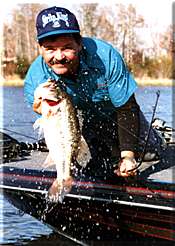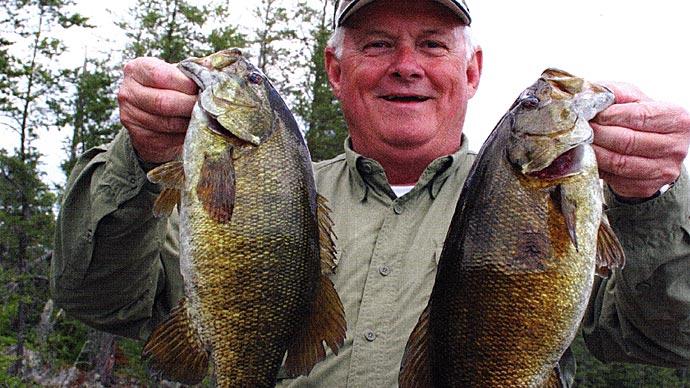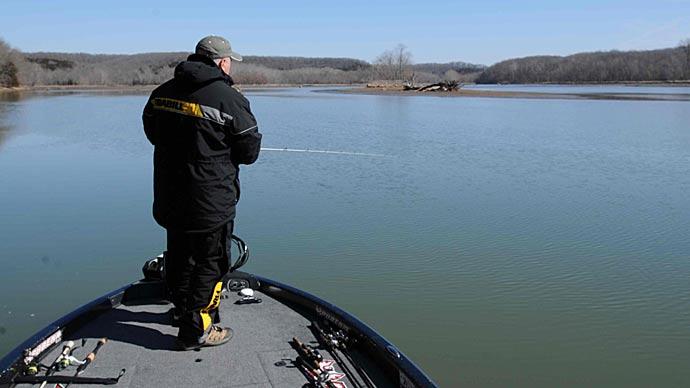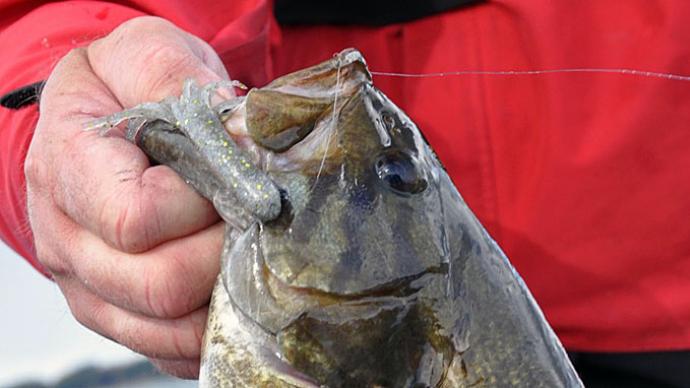
If there is a misunderstood bass tactic, Finesse fishing is it. Several myths about Finesse fishing have been fostered by bass fishermen who have little or no experience with the technique and even less success. Many anglers believe Finesse fishing only catches small fish. It doesn't. I've had people tell me Finesse fishing won't win tournaments. It does. When properly used, Finesse fishing can help put a limit of big bass in the boat when other techniques fail.
Finesse fishing is essentially nothing more than downsizing a particular type of bait or lure. When it comes to winter fishing or those times throughout the year when fish are inactive, most anglers will find more success at catching bass by downsizing or Finesse fishing.
Finesse fishing patterns are usually fished at a much slower rate due to the inactive bass during these periods. The most significant factor an angler should be aware of is that the bass's metabolism slows way down in colder water temperatures, thus making them very inactive or sluggish. Bass won't expend significant amounts of energy during these colder water temperatures. By nature, it seems that a bass will always expend the least amount of energy for the greatest amount of benefit. That's why a bass is considered more of an ambush fish than a chaser.
There are a few tricks or, as some would say, a few how-to's when fishing a Finesse pattern. I'll explain some of these techniques and patterns used for Finesse fishing that may help you become a better angler when it comes to these cold water or inactive periods.
First, let's talk about plastics. 4-inch Plastic baits such as French fries (also known as centipedes), grubs, worms, crawls, tubes, or any other smaller types of soft plastic baits are an excellent choice to use for Finesse fishing. Rig these baits like a "Texas Rig" using a thin wire hook and lightest weight possible (just light enough, so the plastic bait barely falls through the water). Let the bait completely fall to the bottom, and make a slow-twitch, slowly reel the bait back in, then do it again.
One of the most popular Finesse rigs is the splitshot rig. By duplicating the natural swimming motion with the slow, steady retrieve of a small 4-inch worm, splitshotting is a very efficient means of force-feeding unaggressive bass. In most cases, this is accomplished by Texas rigging a 4-inch curl-tail worm or 3-inch grub on a straight shank, perfect bend Aberdeen style hook with a splitshot crimped 18- to 24-inches up on 6-pound test line. The Aberdeen hook is used because it provides a keel to the worm, which keeps the worm on a straight and level course like a boat's keel.
One rig that has proven to be deadly is the "Double Rig." Sometimes, when you're unsure what type of baits to use, the "double rig" allows you to use two baits simultaneously. First, tie a Jig-n-pig on your line, then tie a 2- to 4-foot leader off of the Jig-n-Pig. Tie a hook on the end of the leader (making sure that you use no weight) and rig a plastic bait on the hook. Work this pattern just as you would a Carolina Rig. Now, you have two choices for the bass to zero in on.
By the way, Carolina Rigs can also be used for Finesse fishing! Just use lighter hooks, weights, and baits.
So what about hard baits? Let's say you're fishing a Crankbait Pattern during one of these cold or inactive periods. You notice on your graph that the bass are in the 20' to 40' depth and the shad or baitfish are only small in size. How would you get a small crankbait to dive down to these depths? Easy! Tie a small crankbait on a Carolina Rig! Again, the key in Finesse fishing is downsizing your lure. You can fish any depth you want with any lure you choose with a bit of creativity.
Let's talk a little about technique. Splitshotting is a horizontal, moving-bait technique used when bass moves through or holds 20 feet or less water. Although some fishermen place a splitshot on their line and call it splitshotting, the essence of the technique is in the moving bait tactic. Without the movement, you're merely placing a plastic worm in the water with a weight up the line. While this method works, particularly with reapers, it's more an example of fishing with a splitshot than splitshotting.
Since the proper retrieve maintains constant bottom contact with the splitshot while moving the bait at a slow but steady pace, splitshotting covers water faster than just about any conventional worming method. Splitshotting more closely resembles crankbait fishing than it does plastic worming. And as a result, this method is especially lethal at locating fish concentrations or intercepting bass as they move up during daily migrations.
If the water is more than 40' deep, splitshotting loses effectiveness. Try to find any structure within this depth, such as a steep bank, rocks, or a few drops. Position your boat in the deeper water, cast over these areas with a Texas-rigged bait, and let the pendulum fall (swing) itself back under the boat. Observe your line and be aware of what your rod is doing. If at any time something seems different, set the hook!
Suppose you have underwater structures like treetops, old buildings, rocks, and underwater vegetation. A technique is known as "doodling" can successfully catch bass. When "doodling" a Finesse bait, suspend the bait just over these structure areas and lightly twitch the bait, then let it just hang. Repeat this again, leaving the bait in the water just above the structure, and hold on!
There are more techniques and patterns to use for Finesse fishing, but these are a start for you to try. Finesse fishing techniques can be used year-round and will bring success to you when nothing else seems to work. Try these methods and see!
I enjoy helping anglers learn to be more successful at catching bass! Please always practice "Catch & Release. God Bless! Good Luck!




